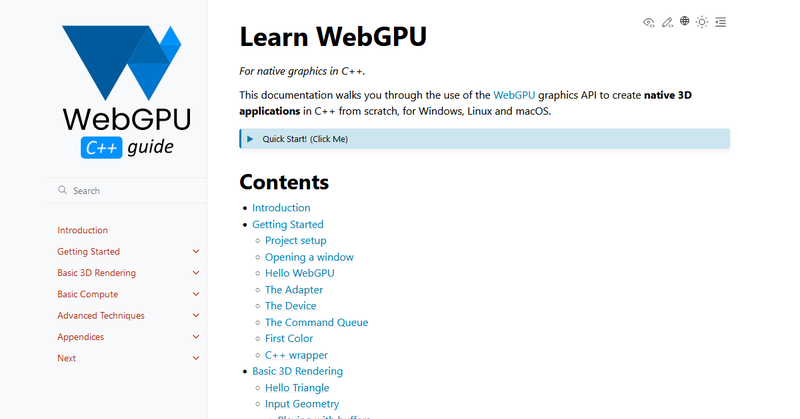
Élie Michel 🍪
@exppad
Followers
4K
Following
2K
Media
382
Statuses
1K
Research Scientist at @AdobeResearch. PhD in Computer Graphics. Dev of #OpenMfx and Learn #WebGPU C++. Opinions are my own. ⏩ https://t.co/lDVZsdOOuw
Paris
Joined November 2015
I also gather some related toughts in this appendix of the #LearnWebGPU programming guide: "Keep in mind lower-end devices"
eliemichel.github.io
This documentation walks you through the use of the WebGPU graphics API to create native 3D applications in C++ from scratch, for Windows, Linux and macOS.
0
2
4
We're very much interested in your opinion and interpretation of these results! More info about the upcoming talk: 🔹SIGGRAPH program: https://t.co/0eCv0bN62a 🔹Webpage: https://t.co/D05pUZuSw6 with @emxtyu Octave Crespel @Axel_Paris and @FelixHahnlein
1
0
2
The fact is that research papers are mostly tested on the very top tier of GPUs available the year they are published (and publication takes time, so they're actually even more ahead).
1
1
3
Is it because researchers only work with recent high end #GPU that everybody has to renew their hardware so fast or is the other way around? Causality is hard to prove, but the correlation is a fact! And we have plenty more figures to show at our #SIGGRAPH2025 talk next summer!
1
2
6
Note that 'naga' is the equivalent tool developed by Firefox. It can easily be installed using cargo (the rust build manager): https://t.co/EWw0tlN3N6
0
0
9
'tint' is the shader compiler developed by Chrome to implement #WebGPU. It has a nice command line interface, but so far there is no official build out... Wait no more! I share here precompiled binaries of tint CLI: https://t.co/frcOqs9ALw
1
13
64
Important notes: 🔹This rewrite is *WIP*, refer to the main section (w/o "next" in the URL) for further chapters. 🔹This only works with Dawn for now because it is closer to what the v1.0 of WebGPU will be. 🔹The accompagnying code "stepXXX-next" is not up to date yet.
0
0
0
I've just realized something. It makes much more sense to have the "hello triangle" pointing upside down when learning #WebGPU! 👉 The ongoing "Next" rewrite of my guide reached the Hello Triangle chapter 🥳 https://t.co/C1AEC7S6Kj
1
0
16
🏅Honored to have been awarded at #Eurographics25 for our paper on #LipschitzPruning to speed-up SDF rendering! 👉 The paper's page: https://t.co/769eLLiAFE Congrats to @wilbarbier, M. Sanchez, @Axel_Paris, T. Lambert, @boubek , M. Paulin and T. Thonat!
6
3
54
On my way to #Eurographics, where we'll present our recent work on fast #SDF rendering! More than 500x #speedup on some complex scenes, addressing a key scalability issue of #ImplicitSurfaces modeling! Webpage: https://t.co/769eLLiAFE cc @wilbarbier @Axel_Paris @boubek
3
33
206
PS: I'll be in #Eurographics next week, feel free to get in touch!
0
0
1
New update post about the 🚧 Ongoing work! 🚧 in my LearnWebGPU C++ guide! On patreon: https://t.co/CPp7r3buuS On Discord: https://t.co/TdhXK3OJqf Outline: 🔹 The LearnWebGPU guide 🔹 WebGPU-distribution 🔹 RenderDoc 🔹 WebGPU-C++ 🔹 GLFW and SDL 🔹 Slang x WebGPU 🔹 ...
1
2
16
Starting to track down the usage of #WebGPU resources during a frame in my custom #RenderDoc driver! (Don't mind the usage field, it's a placeholder value for now)
0
0
7
Starting to nest events in the #WebGPU driver for #RenderDoc, how do you think I should handle these "WriteBuffer" that occur while encoding a "RenderPass"? Because chronologically they are submitted before the render pass even though the API call occurs after.
0
0
4
Who would be interested in a version of #RenderDoc that captures and replays calls to the #WebGPU API (rather than calls to the underlying DirectX/Vulkan/Metal API)? This is an early test that only lists the API calls, but already promissing! Will share when usable.
1
0
5
🥳 A huge congrats to all my co-authors! @marziarice_, @Axel_Paris, @vdeschaintre, Mathieu Gaillard ( https://t.co/1Xs4uCxmxy),
@Xelatihy 8/8
0
0
4
The results: Our approach provides more expressive manipulation capabilities than solutions that do not augment the implicit function to help tracking down a point's identity! More info and results on the web page! 👉 https://t.co/9TQLcQV1km 7/8
1
1
2
The solution: We #augment the output of the implicit function so that it also returns a vector that represents the #identity of the point. This then enables using the conveniently called Implicit Function Theorem https://t.co/28DYqUpIYJ, giving in the end a simple formula. 6/8
1
0
0
The challenge: The constrained point (the one we click and drag), only exists in the #current version of the shape: only once we can track it down in other #variations we may define its #derivative wrt. proc parameters. Not easy, when the entire shape is only #implicit! 5/8
1
0
0

